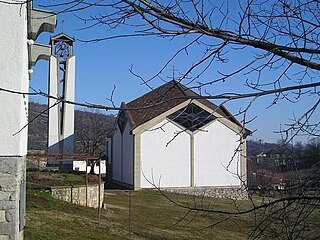
Junik is a town and municipality in the Gjakova District in western Kosovo.

Ratkovac, 'Ratkoc' or 'Ratkoci', is a small village in Kosovo. The village is about 12 km (7 mi), by road, from the city of Gjakova, but only 2 km (1 mi) by geographical distance. The name Ratkovac means Place of a warrior in serbian, derived from the Serbian word rat, which means war.
Golaj is a village and a former municipality in the Kukës County, northeastern Albania. At the 2015 local government reform it became a subdivision of the municipality Has. The population at the 2011 census was 6,187. In the Ottoman Defter of 1571 for the Sanjak of Dukagjin, Golaj was part of the Nahiya of Pashtrik and was part of the timar of Hasan. The inhabitants of Golaj had a predominantly Christian Albanian anthroponomy with a degree of Islamisation: Mustafa Koka, Iljas Koka, Hasan Deja, Ali Deja, Memi Tusha, Ali Puta, Hasan Tola, Ahmed Benku, Papa Deja, Deda Papa, Tita (Dida) Gjeci, Prend Tita (Dida), Deda Kola, Benk Gika, Gjon Gjika, Mark Koka, Gjin Deja, Gjin Lika, Tola Koka, Gjon Lika, Gjin Andrea, Nina Gjoni, Papa Tola, Kola Bardi, Papa Nina, Papa Baci, Puta Gika, Bac Puta, Draga Progoni, Deja Lika, Gjon Lika, Draga Maza, Gjon Lika, Progon Gjura, Lika Progoni, Diraga Draga, Vata Gika, Kraga Gika, Gjon Vata, Biba Gaci, Mark Gaci, Gika Dida, Gjec Deda, Lika Kola. There were 35 Christian homes in total, and 8 Muslim household heads - all Albanian.
Grudë is a settlement in the former Gruemirë municipality, Shkodër County, northern Albania. At the 2015 local government reform it became part of the municipality Malësi e Madhe. In 1485, the village's inhabitants maintained Albanian anthroponomy, indicating Albanians inhabited the village during this time.

The Sanjak of Scutari or Sanjak of Shkodra was one of the sanjaks of the Ottoman Empire. It was established after the Ottoman Empire acquired Shkodra after the siege of Shkodra in 1478–9. It was part of the Eyalet of Rumelia until 1867, when it became a part, together with the Sanjak of Skopje, of the newly established Scutari Vilayet. In 1912 and the beginning of 1913 it was occupied by members of the Balkan League during the First Balkan War. In 1914 the territory of Sanjak of Scutari became a part of the Principality of Albania, established on the basis of the peace contract signed during the London Conference in 1913.

Zym or Zjum is a village in the Prizren Municipality of southwestern Kosovo.

Deçan Municipality or Dečani Municipality is a municipality located in the District of Gjakova of Kosovo. The seat is the town of Deçan. According to the 2011 census, the municipality has 40,019 inhabitants, with 3,803 inhabitants in the town of Deçan.
Damjan is one of the largest villages in the District of Gjakova, Kosovo.
Xërxë is a village in Rahovec municipality.
Lubizhdë is a village in the Prizren municipality in southern Kosovo.
Piranë is a village in Prizren municipality, Kosovo. During the 15th-16th century, the inhabitants of the village were recorded with characteristically Albanian anthroponomy, indicating that the village was historically inhabited by Albanians.
Romajë is a village in the Prizren municipality of Kosovo. It has 2,747 inhabitants as of 2011. The area of Romajë is the site of a multi-layered settlement of the pre-Roman Iron Age, the Roman era, and the medieval era. Excavations at the necropolis of Romajë have revealed extensive burial mounds (tumuli) of classical antiquity.
Gjinoc is a village in Suharekë municipality, Kosovo.
Dujakë is a village in the Gjakova municipality of Kosovo. It is located 8–10 km from Gjakova on the Gjakova-Peja highway.
Voksh is a village and tribal region situated in western Kosovo, which is inhabited by 570 people, all of whom are Albanians. The village of Voksh is also home to the Vokshi tribe which is part of the larger polyphyletic Thaçi tribe.
Zojz is a settlement in the Prizren Municipality, southwestern Kosovo.
Kojushë is a village in the Prizren District of Kosovo. The village is part of the Has region.
Shpenadi is a village in the District of Prizren, Kosovo.
Caparc is a village in the district of Prizren, Kosovo.
Guskë is a village in District of Gjakova, Kosovo. Guskë is situated nearby to the village Korenicë and the hamlet Rrasa e Gjoni. The village is part of the Has region.





